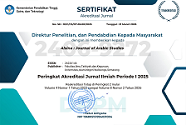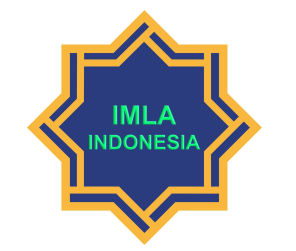Conventional and Contemporary Arabic Language Teaching Methods: A Comparative Analysis
DOI:
https://doi.org/10.21580/alsina.6.2.23307Keywords:
Arabic language teaching, comparative analysis, contemporary methods, conventional methods, language educationAbstract
This study compares conventional and contemporary Arabic language learning methods to analyze their effectiveness, assessment strategies, and integration in Indonesia's context of pesantren and madrasah. Using a literature review approach, this research examines conventional methods (grammar-translation, direct, audio-lingual) and contemporary methods (eclectic, communicative, technology-based). The findings reveal that conventional methods, dominant in pesantren, excel in building grammatical foundations and understanding classical texts but lack emphasis on practical communication skills. Conversely, contemporary methods, prevalent in madrasahs, enhance speaking and student engagement through technology and interactive activities, though they require robust infrastructure and teacher training. Assessment strategies range from written tests for conventional methods to project-based and online assessments for contemporary methods. An integrated model combining grammar-translation, communicative, and technology-based approaches is proposed to address diverse learner needs across beginner, intermediate, and advanced levels.
Downloads
References
A. Rani, Samsuar et al. “Arabic Language Learning Based on Technology (Opportunities and Challenges in the Digital Era).” International Journal of Education, Language, and Social Science 1, no. 1 (2023): 1–11. https://doi.org/10.62612/ijelass.v1i1.4.
Achoita, Ana. “Bahasa Arab dan Metode Pengajarannya.” Tadris : Jurnal Penelitian dan Pemikiran Pendidikan Islam 12, no. 2 (2019): 1–17. https://doi.org/10.51675/jt.v12i2.20.
Aflisia, Noza, and Hazuar Hazuar. “Pengembangan Bahan Ajar Bahasa Arab Berbasis Pendekatan Komunikatif.” Arabiyatuna : Jurnal Bahasa Arab 4, no. 1 (2020): 111. https://doi.org/10.29240/jba.v4i1.1380.
Afroni, Mochammad. “Metode Sam’iyah Safawiyah dalam Pembelajaran Bahasa Arab.” Al-Lahjah : Jurnal Pendidikan, Bahasa Arab, dan Kajian Lingustik Arab 2, no. 1 (2019): 19–28. https://doi.org/10.32764/lahjah.v2i1.382.
Alrasi, Fitri. “Penggunaan Metode Eklektik (Thariqah Intiqoiyyah) terhadap Pembelajaran Bahasa Arab di AKPER Aisyiyah Padang.” Jurnal Kajian dan Pengembangan Umat 1, no. 1 (2018): 93–102. https://jurnal.umsb.ac.id/index.php/ummatanwasathan/article/view/1122.
Aminah, Sri Nurul. “Metode-Metode Pembelajaran Bahasa Arab.” In Prosiding Semnasbama IV, 4:159–66, 2020. https://prosiding.arab-um.com/index.php/semnasbama/article/view/600.
Andriani, Tuti. “Sistem Pembelajaran Berbasis Teknologi Informasi dan Komunikasi.” Sosial Budaya : Media Komunikasi Ilmu-ilmu Sosial dan Budaya 12, no. 1 (2015): 127–50. https://media.neliti.com/media/publications/164486-ID-sistem-pembelajaran-berbasis-teknologi-i.pdf.
Aqeela, M.M.F. et al. “Traditional and Modern Teaching Methods in Teaching Arabic as a Second Language: A Comparative Study.” Sprin Journal of Arabic-English Studies 2, no. 3 (2023): 48–53. https://doi.org/10.55559/sjaes.v2i03.52.
Bakri, Muhammad Ali. “Metode Langsung (Direct Method) dalam Pengajaran Bahasa Arab.” Al-Maraji’ : Jurnal Pendidikan Bahasa Arab 1, no. 1 (2017): 1–12. https://doi.org/10.26618/almaraji.v1i1.2385.
Baroroh, R. Umi, and Syindi Oktaviani R Tolinggi. “Arabic Learning Base On A Communicative Approach In Non-Pesantren School.” Ijaz Arabi Journal of Arabic Learning 3, no. 1 (2020). https://doi.org/10.18860/ijazarabi.v3i1.8387.
Bruinessen, Martin. “Kitab Kuning; Books in Arabic Script Used in the Pesantren Milieu; Comments on a New Collection in the KITLV Library.” Bijdragen Tot de Taal-, Land- En Volkenkunde / Journal of the Humanities and Social Sciences of Southeast Asia 146, no. 2 (1990): 226–69. https://doi.org/10.1163/22134379-90003218.
Burhanudin, Jajat. “Two Islamic Writing Traditions in Southeast Asia: Kitab Jawi and Kitab Kuning with Reference to the Works of Da’ud Al-Fatani Dan Nawawi Al-Bantani.” Al-Jami’ah: Journal of Islamic Studies 60, no. 1 (2022): 1–28. https://doi.org/10.14421/ajis.2022.601.1-28.
Furoidah, Asni. “Media Pembelajaran dan Peran Pentingnya dalam Pengajaran dan Pembelajaran Bahasa Arab.” Al-Fusha : Arabic Language Education Journal 2, no. 2 (2020): 63–77. https://doi.org/10.36835/alfusha.v2i2.358.
Hamzah, Alifia et al. “Analisis Komparatif Teknik Penceritaan dan Pengembangan Karakter pada Film Mencuri Raden Saleh dan Ocean’s Eleven.” Judikatif: Jurnal Desain Komunikasi Kreatif 5, no. 1 (2023): 49–58. https://doi.org/10.35134/judikatif.v5i1.113.
Haq, Muhammad A’inul et al. “Paradigma Pembelajaran Bahasa Arab (Analisis Kontrastif Metode Pembelajaran Konvensional dan Kontemporer).” Takuana: Jurnal Pendidikan, Sains, dan Humaniora 2, no. 1 (2023): 63–75. https://doi.org/10.56113/takuana.v2i1.71.
Jamil, Husnaini, and Nur Agung. “Tantangan Pembelajaran Bahasa Arab di Era Society 5.0: Analisis Pembelajaran Bahasa Arab Berbasis Aplikasi Interaktif.” Alibbaa’: Jurnal Pendidikan Bahasa Arab 3, no. 1 (2022): 38–51. https://doi.org/10.19105/ajpba.v3i1.5536.
Jamil, Husnaini, and Sardiyanah. “Eksistensi Metode Qawaid Tarjamah dalam Pembelajaran Bahasa Arab di Era Revolusi 4.0.” NASKHI : Jurnal Kajian Pendidikan dan Bahasa Arab 2, no. 1 (2020): 30–39. https://doi.org/10.47435/naskhi.v2i1.289.
Kaharuddin, Andi. “The Communicative Grammar Translation Method: A Practical Method to Teach Communication Skills of English.” ETERNAL (English, Teaching, Learning, and Research Journal) 4, no. 2 (2018): 232–54. https://doi.org/10.24252/Eternal.V42.2018.A8.
Khusniya, Elok Nadlirotul et al. “Dinamika Mengajar Thariqah Intiqaiyyah secara Daring.” In Prosiding Konferensi Nasional Bahasa Arab dan Pembelajarannya di Era Milenial, 1:703–14. Surabaya: UIN Sunan Ampel Surabaya, 2022. https://proceedings.uinsa.ac.id/index.php/KPBA/article/view/902.
Lestari, Sri Indah et al. “Penerapan Metode Audiolingual dalam Pembelajaran Keterampilan Menyimak Bahasa Arab secara Daring: Studi Kasus di SMPIT Adzkia Padang.” Alsina : Journal of Arabic Studies 6, no. 1 (2024): 27–46. https://doi.org/10.21580/alsina.6.1.23100.
Leuwol, Ferdinand Salomo et al. “Efektivitas Metode Pembelajaran Berbasis Teknologi terhadap Peningkatan Motivasi Belajar Siswa di Sekolah.” EDUSAINTEK: Jurnal Pendidikan, Sains dan Teknologi 10, no. 3 (2023): 988–99. https://doi.org/10.47668/edusaintek.v10i3.899.
Mardiyah, Siti Milatul. “Metode Eklektik Dalam Pembelajaran Bahasa Arab.” Tarbiyatuna: Jurnal Pendidikan Ilmiah 5, no. 1 (2020): 119–43. https://doi.org/10.55187/tarjpi.v5i1.3906.
Masoudzade, Azar Bagheri, and Razieh Hashemi Lahijani. “Communicative Language Teaching Method (CLT) and Final Examination of Iranian EFL Learners.” International Journal of Language and Translation Research 1, no. 3 (2021): 71–90. https://doi.org/10.12906/978389966737_004.
Munib, Achmad, and Fitria Wulandari. “Studi Literatur: Efektivitas Model Kooperatif Tipe Course Review Horay dalam Pembelajaran IPA di Sekolah Dasar.” Jurnal Pendidikan Dasar Nusantara 7, no. 1 (2021): 160–72. https://doi.org/10.29407/jpdn.v7i1.16154.
Munip, Abdul. “Tracing the History of the Arabic-Javanese Language Translation Books in Nusantara Islamic Education.” Jurnal Pendidikan Islam 5, no. 1 (2016): 43–67. https://doi.org/10.14421/jpi.2016.51.43-67.
Nurcholis, Ahmad et al. “Epistemology of Arabic Language Learning Technology Development.” Jurnal Al Bayan: Jurnal Jurusan Pendidikan Bahasa Arab 13, no. 1 (2021): 73–89. https://doi.org/10.24042/albayan.v13i1.7090.
Panigoro, M Rifian, and Abdur Rahman Adi Saputera. “Implementasi Metode Sam’iyah Syafahiyah pada Siswa sebagai Upaya Meningkatkan Kemampuan Penguasaan Mufradat.” `A Jamiy : Jurnal Bahasa dan Sastra Arab 9, no. 2 (2020): 164–78. https://doi.org/10.31314/ajamiy.9.2.164-178.2020.
Rahmawati, Eka Dewi. “Pendekatan Komunikatif Dalam Tes Kemampuan Berbicara Bahasa Arab.” Lugawiyyat 3, no. 1 (2021): 59–77. https://doi.org/10.18860/lg.v3i1.12321.
Ritonga, Mahyudin et al. “Strategies for Developing Tarkib Arabic Exercises Instruments for Strengthening the Understanding of Yellow Book.” International Journal of Entrepreneurship 25, no. Special Issue 1 (2021).
Ritonga, Mahyudin. “Utilizing Technology to Improve the Quality of Learning in Indonesia: Challenges and Consequences for Arabic Teachers.” Arabiyat : Jurnal Pendidikan Bahasa Arab Dan Kebahasaaraban 9, no. 1 (2022): 56–68. https://doi.org/10.15408/a.v9i1.24516.
Rohman, Faedur. “Tadrīs al-Taʿbīr al-Shafahī bi-al-Ṭarīqah al-Ittiṣālīyah li-Ṭullāb Qism Taʿlīm al-Lughah al-ʿArabīyah bi-Jāmiʿat Muḥammadīyah Tangerang.” Jurnal Al Bayan: Jurnal Jurusan Pendidikan Bahasa Arab 10, no. 2 (2018): 172–86. https://doi.org/10.24042/albayan.v10i2.2833.
Rokhhmatulloh, Nur. “Metode Pembelajaran Bahasa Arab.” Studi Arab 8, no. 1 (2017): 15–30. https://jurnal.yudharta.ac.id/v2/index.php/studi-arab/article/view/1753.
Said, Sayuthi Atman, and Ahmad Hashif Ulwan. “Integration of Technology in Learning Arabic Language: Mumtaz Method Textbook with Interactive Power Point Features.” ALSUNIYAT: Jurnal Penelitian Bahasa, Sastra, Dan Budaya Arab 6, no. 2 (2023): 146–58. https://doi.org/10.17509/alsuniyat.v6i2.63881.
Sam, Zulfiah. “Metode Pembelajaran Bahasa Arab.” Nukhbatul ’Ulum 2, no. 1 (2016): 206–20. https://doi.org/10.36701/nukhbah.v2i1.16.
Sardiyana, Sardiyana. “Pendekatan dan Metode Audio Lingual (Analisis Metode Sam’iyah Safawiyah).” NASKHI :Jurnal Kajian Pendidikan dan Bahasa Arab 1, no. 1 (2019): 14–20. https://doi.org/10.47435/naskhi.v1i1.67.
Sherina, Putri, and Faisal Hendra. “Analisis Komparatif antara Metode Gramatika Terjemah dan Metode Langsung dalam Pembelajaran Bahasa Arab.” Jurnal Multidisiplin West Science 3, no. 3 (2024): 255–63. https://doi.org/10.58812/jmws.v3i03.1031.
Sodik, Achmad Ja’far et al. “Research Trends in the Analysis of Elementary Level Arabic Textbooks: Systematic Literature Review.” Borneo Journal of Language and Education 4, no. 1 (2024): 18–30. https://doi.org/10.21093/benjole.v4i1.8044.
Susilawati, Ulfah. Metodologi Pembelajaran Bahasa Arab : Teori dan Aplikasi. Yogyakarta: Kreasi Total Media, 2020.
Thohir, Muhammad et al. Metode Pembelajaran Bahasa Arab Sebagai Bahasa Asing. Sidoarjo: Kanzum Books, 2021.
Valledor, Adrián et al. “The Eclectic Approach in English Language Teaching Applications: A Qualitative Synthesis of the Literature.” Sustainability 15, no. 15 (2023): 11978. https://doi.org/10.3390/su151511978.
Zaidan, Muhammad Farhan et al. “Penerapan Metode Pembelajaran TBL (Technology Based Learning) pada Mata Pelajaran PPKN Menggunakan Aplikasi Quizizz untuk Meningkatkan Hasil Belajar Siswa Kelas IV SD Namira Kraksaan Kabupaten Probolinggo.” Innovative: Journal Of Social Science Research 4, no. 2 (2024): 6921–36. https://doi.org/10.31004/innovative.v4i2.10117.
Zakariah, M. Askari et al. Metodologi Penelitian: Kualitatif, Kuantitatif, Action Research, Research and Development. Kolaka: Yayasan Pondok Pesantren Al Mawaddah Warrahmah, 2020.
Zed, Mestika. Metode Kepustakaan. Yayasan Pustaka Obor Indonesia, 2018.
Downloads
Published
How to Cite
Issue
Section
License
Copyright (c) 2024 Alsina : Journal of Arabic Studies

This work is licensed under a Creative Commons Attribution-NonCommercial-ShareAlike 4.0 International License.
Copyright
The copyright of the received article shall be assigned to the publisher of the journal. The intended copyright includes the right to publish the article in various forms (including reprints). The journal maintains the publishing rights to published articles. Authors are allowed to use their articles for any legal purposes deemed necessary without written permission from the journal, but with an acknowledgment to this journal of initial publication.
Licensing
In order for Alsina: Journal of Arabic Studies to publish and distribute research articles, the editors need publishing rights (transferred from author to publisher). This agreement relates to the transfer/publishing copyright license to Alsina: Journal of Arabic Studies but the authors still have significant rights to use and share their published articles.
Alsina: Journal of Arabic Studies supports the need for writers to share, disseminate and maximize the impact of their research and their rights on any database. As a journal article writer, you have the right to various uses of your articles, including that by the institution or company where you work. Copyright can be used without the need for special permission. Authors who publish articles in the Alsina: Journal of Arabic Studies have broad rights to use their work for teaching and scientific purposes without requesting permission, including:
- Use by the author for lectures, presentations, or conferences, with distribution of copies to participants;
- Distribution to colleagues for research use;
- Use in compilations of the author's subsequent work;
- inclusion in a thesis or dissertation;
- Reuse of sections or excerpts from articles in other works (with full acknowledgment of the final article);
- Preparation of derivative works (other than commercial purposes) (with full acknowledgment of the final article);
- Voluntary posting on open websites operated by authors’ or writers' agencies for scientific purposes
When submitting a manuscript, authors do so on the understanding that if accepted for publication, the copyright for publishing (publishing right) of the article shall be assigned/transferred to Alsina: Journal of Arabic Studies.
Authors whose articles are accepted for publication will receive confirmation via email and sent a Copyright Transfer Agreement.

 Accreditation
Accreditation 
 In Collaboration with
In Collaboration with 

 Visitors
Visitors  Article Template
Article Template





